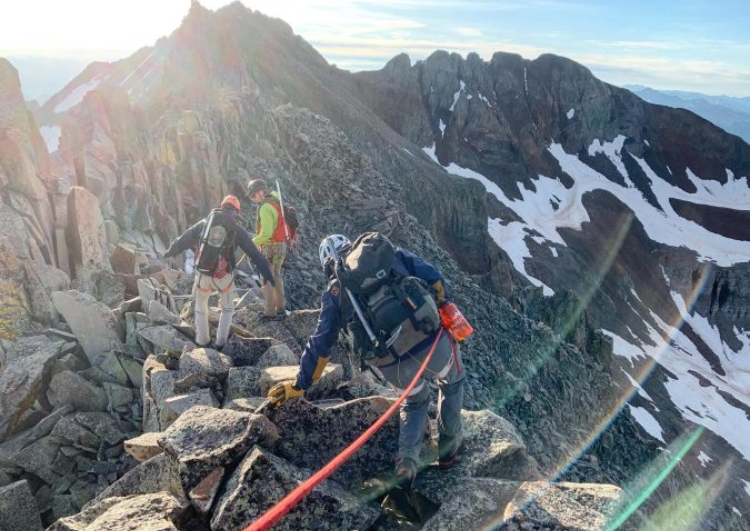
The San Juan Mountains are located in southwestern Colorado, USA. They form a large and rugged mountain range known for their stunning scenery and outdoor recreational opportunities.
A. Tell me more about the San Juan Mountains.
B. What are some popular activities to do in the San Juan Mountains?
C. Can you provide some interesting facts about the San Juan Mountains?


The San Juan Mountains have existed for millions of years, formed through geological processes such as uplift and erosion. However, they gained prominence in the mid-1800s during the Colorado Gold Rush, when miners flocked to the region in search of precious metals like gold and silver. The area's rich mineral deposits played a significant role in the settlement and development of Colorado during that time.

The San Juan Mountains were not "invented" by any individual. Instead, they were formed over millions of years through geological processes such as uplift, volcanic activity, and erosion. The complex geological history of the region contributed to the creation of the majestic mountain range we see today.


The San Juan Mountains are named after the San Juan River, which flows through the region. The river itself is named after San Juan Bautista (Saint John the Baptist), likely by Spanish explorers or missionaries who ventured into the area in the 17th and 18th centuries. "San Juan" is a common name in Spanish-speaking regions, often used to honor Saint John or to designate places associated with him. So, the mountains inherited their name from the river, which in turn was named by early Spanish explorers or settlers.




The San Juan Mountains are renowned among hiking enthusiasts for several reasons:
1. **Scenic Beauty**: The mountains offer breathtaking scenery, including rugged peaks, alpine meadows, crystal-clear streams, and dense forests. Hikers are treated to stunning vistas at every turn.
2. **Variety of Trails**: There is a wide variety of trails catering to hikers of all skill levels, from easy day hikes to challenging multi-day backpacking routes. Whether you're a beginner or an experienced trekker, you can find trails suited to your preferences and abilities.
3. **Wildlife Viewing**: The San Juan Mountains are home to diverse wildlife, including elk, deer, black bears, mountain goats, and various bird species. Hikers have the opportunity to spot these animals in their natural habitat, adding to the allure of the hiking experience.
4. **Adventure Opportunities**: Beyond hiking, the San Juans offer numerous adventure opportunities such as rock climbing, mountaineering, backpacking, and even winter activities like snowshoeing and cross-country skiing. There's always something new to explore and conquer for those seeking adventure.
5. **Solitude and Serenity**: Despite their popularity, the San Juan Mountains still offer plenty of opportunities for solitude and communion with nature. Many trails lead to remote and pristine wilderness areas where hikers can escape the crowds and immerse themselves in the tranquility of the mountains.
Overall, the San Juan Mountains provide an unparalleled hiking experience, drawing outdoor enthusiasts from around the world to explore their rugged beauty and diverse landscapes.





While the San Juan Mountains offer spectacular hiking opportunities throughout the year, the best time for hiking largely depends on personal preferences and the specific trails you plan to explore. Here's a breakdown of hiking conditions in different seasons:
1. **Spring (March to May)**:
- Spring brings melting snow and blooming wildflowers, making it a beautiful time to hike in the San Juans.
- However, higher elevation trails may still have snowpack, so be prepared for potentially muddy and wet conditions, and check trail conditions before heading out.
2. **Summer (June to August)**:
- Summer is a popular time for hiking in the San Juan Mountains, with warmer temperatures and longer daylight hours.
- Most trails are accessible during this time, and alpine wildflowers are in full bloom, creating stunning landscapes.
- Be prepared for afternoon thunderstorms, which are common in the mountains during summer months.
3. **Fall (September to November)**:
- Fall is another excellent time for hiking, with cooler temperatures and vibrant fall foliage painting the mountainsides.
- Trails tend to be less crowded compared to summer, offering a more tranquil hiking experience.
- Keep in mind that snow can start to accumulate at higher elevations in late fall, so be prepared for changing weather conditions.
4. **Winter (December to February)**:
- Winter hiking in the San Juans is possible but requires additional preparation and equipment, especially at higher elevations.
- Snowshoeing and cross-country skiing are popular winter activities, and some lower elevation trails may still be accessible for hiking.
- Avalanches and icy conditions can pose hazards, so it's essential to check avalanche forecasts and trail conditions before venturing out.
Overall, while the San Juan Mountains offer hiking opportunities year-round, it's important to consider seasonal factors and plan accordingly to ensure a safe and enjoyable hiking experience.